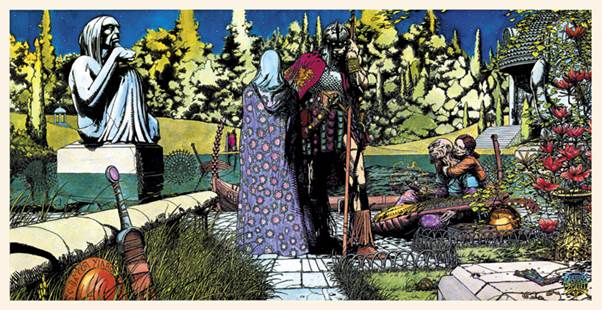If you look at figurative paintings – even our own “Council For Action” emblem – the sense of symmetry is often very profound. Up, down; left, right; and also looking into the picture’s depth of field from you, the viewer. The sense of reality, as well as the iconic significance we get from figures displayed left, right, top, bottom has an underlying simplicity.
So, reality as well as meaning are quite symmetrical. BWS calls his mythical prints “practically Heraldic”, so there is that relation. If you take the plot of Watchmen, it is highly symmetrical; so much so that the end weaves back to the beginning, depending merely on a flick of a coin – fortune.
BWS, along with his fellows of The Studio, represents a revival of figurative art in the grand tradition. Figures placed in a landscape with meaning, tension and movement. The theme of “The Enchantment” (inspired by Cat Stevens, see Alternates 2) is the charm of music and the eternal return. Only figurative art can contain these things which are eternal to Man and to the dramatic vistas of life.

Where you have symmetry you also have fortune, then, since it has something to act on. There is a universal aspect to this, something like Leonardo’s Vitruvian Man which delineates the geometrical/architectural proportions of a classic human figure.
Physique, and the psychic affinity with the universe. Without these two aspects, the facts we are given enter a transformative maze and the human physique is listless and barren (see Weird 2, 6. the transformation of physique in Greek myth, such as Zeus metamorphosing into a bull. In the transformation maze, the physique loses such lustworthy ambitions. See Metamorphosis on the inert pose of iphone addicts vis-à-vis Dali’s painting of Narcissus).
There is a philosophical point here that facts are very precise whereas reality is very imprecise. If you’re looking at an iphone you might be looking at, say, the Dow Jones Index. However, if your head is bowed in the typical iphone pose, the physique is affected notwithstanding. This applies to all precise data – economic, political –since it has no “awareness” of physique and of the placing of figures in a landscape (as a thought experiment, imagine “The Enchantment” if the figures had iphones).
What this basically could mean is that the more factual the world gets, the less real it gets, since the placing of figures - left, right; up, down and through the depth of field - is completely absent. They can talk all they want of reason and pleasure (Weird 7,8), we know they mean a machine-intelligence and a pleasure-droid!
There are two universes here. In one, politicians talk and economists numerate and we are led like the children of Hamelin to a factoid kingdom. There we find pleasure and reason (Weird 7,8). However, because there is no sense of the symmetry of things, no sense of the placing of figures in a landscape, we have no sense of ontology (being) or epistemology (meaning).
In the other, men and women of physique and good intent say nay to the kingdom of distorted facts for their kingdom is the brooding mystery of earth and sea itself. Sprites of the forest (Howard quote Weird 10), the soul of the pea-green sea - here’s an interesting link to an archaic Italian sea-spinner
If you take the Fed, the world’s central bank, all the facts they supply are beyond precise, like clockwork. These facts exist in a distorted maze that exists outside of the simple symmetries of nature and the figurative power and grace of the human form in action. It’s yet another type of weakness that sees order as the only truth whereas a type of disordered symmetry contains the tensions that afflict reality.
Byron in Childe Harold (Aspects 1) is speaking of the lethargy of pleasure that “almost longs for woe”. Noto (Aspects 3) delineates a blood-infested kingdom that is a place of woe and dreadful power and abundance. Howard, in his gloom-infested sprites of the forest, speaks of the ripeness of the dawn that forgets the woes of yore.
This all points to ontology (being) of figures in a landscape that have some meaning (epistemology). Pleasure can become jaded disillusion; reason leads to the modern maze. In this future there is no fortune, no simple twist of fate that makes Man free in fortunate terrain.
Looking down from one of the neighbouring hills, the traveller would have had the impression of standing on the rim of a great natural basin in the bottom of which lay a level terrace, no doubt wooded, enclosed on three sides by a loop in the course of the River Avon. Towards the centre of the terrace was a large marshy swamp with two smaller patches of marsh nearby. From all three, rivulets of water drained down into the river, while over the marsh hung a pall of steam. On a cold winter’s day steam would have filled the valley, leaving only the tops of the tallest trees standing gaunt above the enveloping white blanket. (Rome and the Barbarians page 98, Barry Cunliffe, Bodley Head 1975)
That atmosphere evocative of haunted Howardesque places come from a description of the pre-Roman springs at Bath which, as some of you may not know, is the site of majestic Roman baths (as well as fabulous Georgian crescents). Cunliffe describes how the Romans pragmatically preserved native European shrines and even the gods and goddesses, if they matched Roman ones, were assumed the same.
There is a lot of talk of votive offerings to water deities; sometimes boats laden with weapons were sunk. The primitive desire for fortune.

Water goddess Sequana at woodland grotto source of Seine
This dramatic scene, with its springs of hot bubbling water coating everything with a thick red crust of mineral salts, cannot have failed to impress the pre-Roman population.
The shrine at Bath was dedicated to Sulis-Minerva (Celtic-Roman)

head of Minerva (found 18th c)
Shrines offered hope for diseased pilgrims and..
Sequana’s spring could offer no healing mineral waters to pilgrims – only hope – but there are many sources where the water itself had well-defined medicinal properties. Such a spring emerged from the earth at Chamalieres, not far from.. the Gaulish citadel of Gergovia from which Caeser had been repelled with such devastating casualties during his campaign against Vercingetorix. (page 97)
These natural springs carry the hope, superstitions and fortunes of Man. A question you could ask is, what’s the use of life without hope or fortune? Obviously you can have fact, buy medicinal herbs and drugs, but springs are landscaped grottoes sanctified by naiads of the water. Elemental places of wonder.
Again there are two worlds. One is built on pleasure and reason but has no basic ontology (being) of landscape and of figures with meaning (epistemology). In other words, you can have health without the awareness of spirit of place and, by extension, unconscious urges associated with spirits of place (Dionysus). There is no Apollonian vision because there is no unconscious awareness. This is the same argument from Weird 8: you cannot be healthy with no rhythmic awareness of self. You become an automaton. What “they” are selling. It’s the same with DNA: they want a hybrid-species that is part machine.
Hope springs eternal. Fortune is in the mists of the marsh. The haunted groves are not pleasure-troves; they feed your head and these are the places we have to reclaim in the name of the ancient gods and goddesses who personify them, this hope, this fortune, this future.
What “they” want is a future of no fortune, no hope - hopelessnsess personified in the DNA Dragon - infertile barren grey walkways of aseptic terrain and, above all, no stray dogs (that was a joke as I just read there a million strays in Greece – c’est le classicisme encore). Partly, I think, it’s because they don’t think fortune exists – they’re honest in their own fashion. Planning, planning, planning - Frau Merkel rises to the top of the Scumzone.
So, logic dictates they dig a tunnel under Stonehenge, as it’s all carefully designed and so forth. Sadly, the chalk downs of Salisbury Plain might precipitate a subsidence of the Neolithic shrine
Well I don’t know. All I know is Stonehenge is a landscape of power (ontology) associated with human meaning (epistemology). That’s why it’s sacrosanct like Chichen Itza. The forces these ancient pagan monuments contain stem from fertility and abandon. The great solstices and harvest rituals; the shadow of feathered serpent of the Mayans at equinox.
Again, there seem to be two futures coming into direct conflict. In “our” future, reason (planning) dictates pleasure (sightseeing, parking). I can’t resist here playing a song from One Size Fits All
INCA ROADS
The other future (and past) is desirous of landscapes of awareness and meaning. Since modern Man denies fertility and abandon, he does his level best to undermine these places of power (or at least provide ample parking). In a way, all we really know is that these places are there - like cosmic vaginas. So it’s very cute of May & Co to designate a “carefully landscaped” way of demolishing the allure of a 4,000 year old representative of European culture.
Let’s not forget there are Mycenaean axes carved on the stones, an obvious connection with the Oracle at Delphi, testament to a European-wide culture. The builders were probably Alpine Celts travelling the Danube route from the east, possibly related to earlier builders of New Grange in Ireland, which bears unmistakable traces of Minoan (pre-Mycenaean) influence.
There could be more to glean from the site, unless anyone were fool enough to burrow through the chalk plain. What we’re talking about is the ontology of placements, their overwhelming sense of cosmic power, and their figurative meaning in rituals. Compared to this, the rituals at Westminster are puny. If Westminster were concerned with placements and with figures in landscapes, they would never go anywhere near Stonehenge, but they are only concerned with reason (facts) and pleasure (money), so their archaic rituals are a fraud (Alternates 4).
If landscapes of awareness are of no interest to politicians this might be a good time to invoke the name of Jean Jacques Rousseau (Aspects 3), the early American settlers, Puritan communes, the homebound philosophy of Emerson, the elementalism of Whitman.
NEXT: “WORMS OF THE EARTH”
Home







